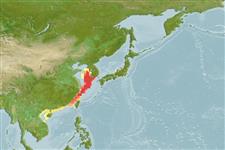Classification / Names
Common names | Synonyms | Catalog of Fishes (gen., sp.) | ITIS | CoL | WoRMS | Cloffa
Actinopterygii (ray-finned fishes) >
Perciformes (Perch-likes) >
Gobiidae (Gobies) > Gobionellinae
Etymology: Chaeturichthys: Greek, chaite = hair + Greek, oura = tail + Greek, ichthys = fish (Ref. 45335); jeoni: Named for Sang-Rin Jeon, Professor Emeritus of Sang Myung University, Seoul.
Environment / Climate / Range
Ecology
Marine; demersal; depth range 11 - 110 m (Ref. 93271), usually 43 - 85 m (Ref. 93271). Subtropical, preferred ?
Western Pacific: Bohai Sea to East and South China seas.
Size / Weight / Age
Maturity: Lm ? range ? - ? cm
Max length : 22.0 cm SL male/unsexed; (Ref. 93271)
Short description
Morphology | Morphometrics
Dorsal
spines
(total): 8 - 10;
Dorsal
soft rays
(total): 20-22;
Anal
spines: 1;
Anal
soft rays: 18 - 20. This species is distinguished from its only congener, C. stigmatias, by having the following characters: interorbital space scaleless (vs. embedded scales); usually 4 pairs of barbels on ventral surface of head, with 3 pairs of long barbels and a pair of short one (vs. usually 3 pairs of long barbels only); pectoral-fin rays 22-25, modally 24 (vs. 21-23, modally 22); most of pectoral-fin rays are branched, not forming free rays (vs. ventral 3-5 rays of pectoral fin simple, forming free rays); longitudinal scale rows 50-58 (vs. 47-53); transverse scale rows 20-25 (vs. 17-21); predorsal scales 23-29 (vs. 20-22); gill rakers on outer surface of first gill arch 2-6?9-13?12-16 (vs. 4-6 + 11-14 ? 16-19); pseudobranchial filaments 7-13, usually 9-11 (vs. 6-8, usually 7); preopercular canal with pores M' and N' (vs. only with pore N'); longer snout, its length 7.7-10.0% of SL (vs. 6.1-8.1% of SL) (Ref. 93271).
Collected from the continental shelf of East Asia between the Bohai Sea and South China Sea (Ref. 93271).
Life cycle and mating behavior
Maturity | Reproduction | Spawning | Eggs | Fecundity | Larvae
Shibukawa, K. and A. Iwata, 2013. Review of the East Asian gobiid genus Chaeturichthhys (Teleostei: Perciformes: Gobioidei), with description of a new species. Bull. Nat. Mus. Nat. Sci. Ser. A., Suppl. 7:53-66. (Ref. 93271)
IUCN Red List Status (Ref. 115185)
CITES (Ref. 94142)
Not Evaluated
Threat to humans
Harmless
Human uses
More information
Common namesSynonymsMetabolismPredatorsEcotoxicologyReproductionMaturitySpawningFecundityEggsEgg development
Age/SizeGrowthLength-weightLength-lengthLength-frequenciesMorphometricsMorphologyLarvaeLarval dynamicsRecruitmentAbundance
ReferencesAquacultureAquaculture profileStrainsGeneticsAllele frequenciesHeritabilityDiseasesProcessingMass conversion
Tools
Special reports
Download XML
Internet sources
